Improving Financial Performance: Statement Analysis and Ratios
VerifiedAdded on 2023/06/17
|14
|2695
|434
Report
AI Summary
This report provides a comprehensive analysis of financial management concepts, emphasizing the importance of financial statements and ratio analysis in evaluating business performance. It delves into the components of financial statements, including the income statement, balance sheet, cash flow statement, and statement of changes in equity, illustrating how financial ratios are used to compare a company's performance against its competitors and identify strengths and weaknesses. The report includes a financial analysis of a sample organization, assessing its profitability, liquidity, and efficiency based on its income statement and balance sheet. Furthermore, it outlines processes for improving financial performance, such as tracking financial scores, recovering outstanding debts, reducing expenses, selling assets, adjusting prices, consolidating debt, implementing effective marketing strategies, and offering diverse payment options. The analysis concludes that the company has improved profitability and liquidity, but needs to enhance its efficiency through better management of payables, receivables, and inventory.

TOP15742 3005
Paraphrase This Document
Need a fresh take? Get an instant paraphrase of this document with our AI Paraphraser
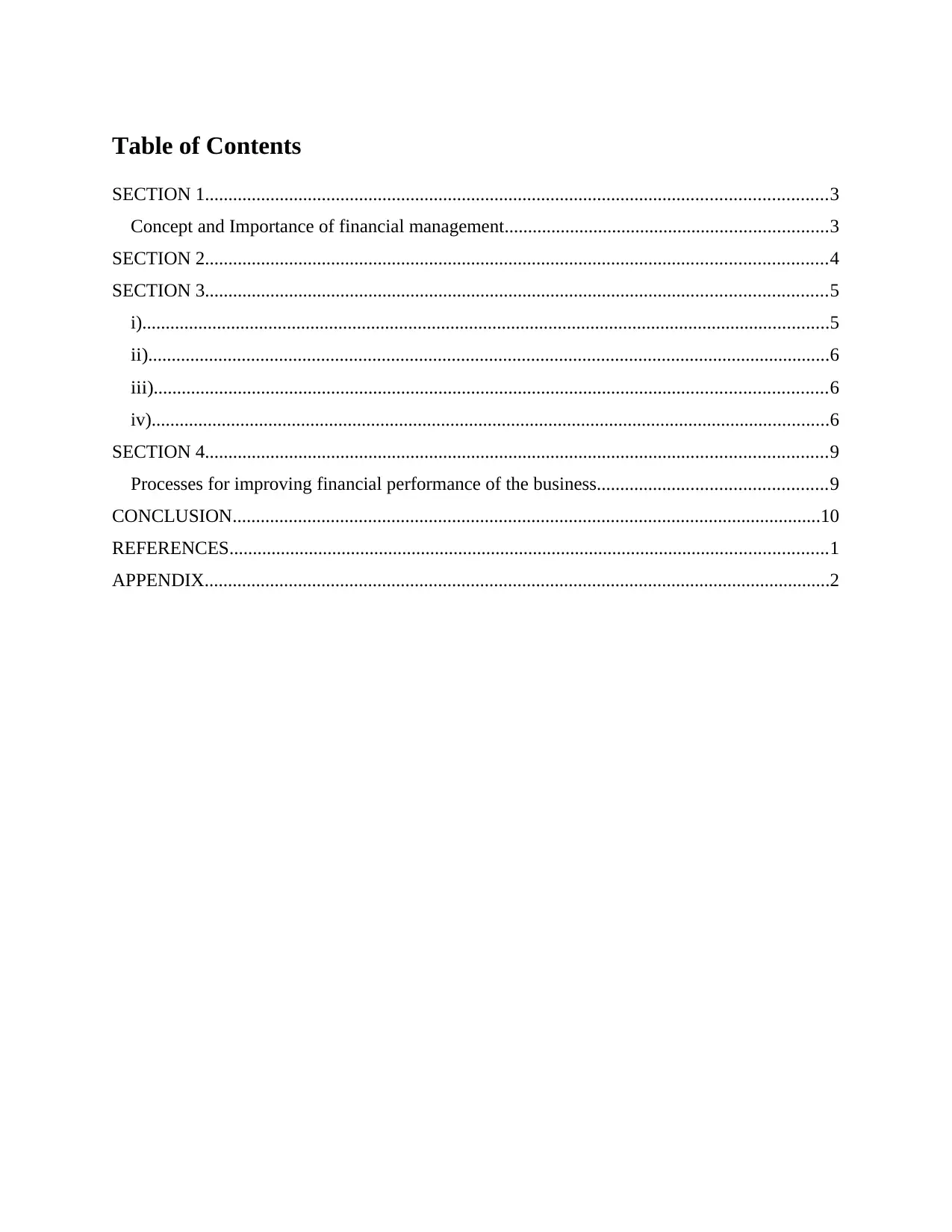
Table of Contents
SECTION 1.....................................................................................................................................3
Concept and Importance of financial management.....................................................................3
SECTION 2.....................................................................................................................................4
SECTION 3.....................................................................................................................................5
i)...................................................................................................................................................5
ii)..................................................................................................................................................6
iii)................................................................................................................................................6
iv).................................................................................................................................................6
SECTION 4.....................................................................................................................................9
Processes for improving financial performance of the business.................................................9
CONCLUSION..............................................................................................................................10
REFERENCES................................................................................................................................1
APPENDIX......................................................................................................................................2
SECTION 1.....................................................................................................................................3
Concept and Importance of financial management.....................................................................3
SECTION 2.....................................................................................................................................4
SECTION 3.....................................................................................................................................5
i)...................................................................................................................................................5
ii)..................................................................................................................................................6
iii)................................................................................................................................................6
iv).................................................................................................................................................6
SECTION 4.....................................................................................................................................9
Processes for improving financial performance of the business.................................................9
CONCLUSION..............................................................................................................................10
REFERENCES................................................................................................................................1
APPENDIX......................................................................................................................................2
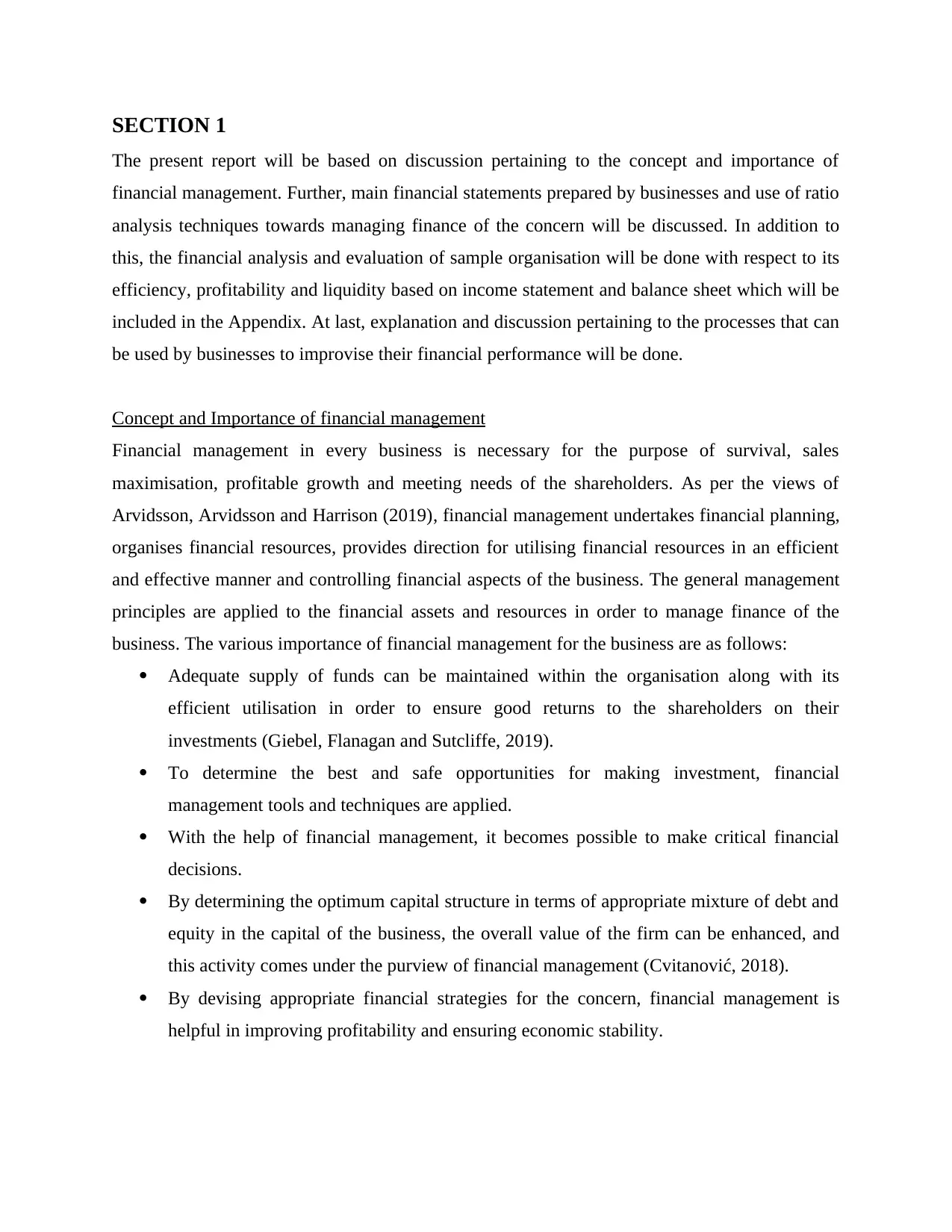
SECTION 1
The present report will be based on discussion pertaining to the concept and importance of
financial management. Further, main financial statements prepared by businesses and use of ratio
analysis techniques towards managing finance of the concern will be discussed. In addition to
this, the financial analysis and evaluation of sample organisation will be done with respect to its
efficiency, profitability and liquidity based on income statement and balance sheet which will be
included in the Appendix. At last, explanation and discussion pertaining to the processes that can
be used by businesses to improvise their financial performance will be done.
Concept and Importance of financial management
Financial management in every business is necessary for the purpose of survival, sales
maximisation, profitable growth and meeting needs of the shareholders. As per the views of
Arvidsson, Arvidsson and Harrison (2019), financial management undertakes financial planning,
organises financial resources, provides direction for utilising financial resources in an efficient
and effective manner and controlling financial aspects of the business. The general management
principles are applied to the financial assets and resources in order to manage finance of the
business. The various importance of financial management for the business are as follows:
Adequate supply of funds can be maintained within the organisation along with its
efficient utilisation in order to ensure good returns to the shareholders on their
investments (Giebel, Flanagan and Sutcliffe, 2019).
To determine the best and safe opportunities for making investment, financial
management tools and techniques are applied.
With the help of financial management, it becomes possible to make critical financial
decisions.
By determining the optimum capital structure in terms of appropriate mixture of debt and
equity in the capital of the business, the overall value of the firm can be enhanced, and
this activity comes under the purview of financial management (Cvitanović, 2018).
By devising appropriate financial strategies for the concern, financial management is
helpful in improving profitability and ensuring economic stability.
The present report will be based on discussion pertaining to the concept and importance of
financial management. Further, main financial statements prepared by businesses and use of ratio
analysis techniques towards managing finance of the concern will be discussed. In addition to
this, the financial analysis and evaluation of sample organisation will be done with respect to its
efficiency, profitability and liquidity based on income statement and balance sheet which will be
included in the Appendix. At last, explanation and discussion pertaining to the processes that can
be used by businesses to improvise their financial performance will be done.
Concept and Importance of financial management
Financial management in every business is necessary for the purpose of survival, sales
maximisation, profitable growth and meeting needs of the shareholders. As per the views of
Arvidsson, Arvidsson and Harrison (2019), financial management undertakes financial planning,
organises financial resources, provides direction for utilising financial resources in an efficient
and effective manner and controlling financial aspects of the business. The general management
principles are applied to the financial assets and resources in order to manage finance of the
business. The various importance of financial management for the business are as follows:
Adequate supply of funds can be maintained within the organisation along with its
efficient utilisation in order to ensure good returns to the shareholders on their
investments (Giebel, Flanagan and Sutcliffe, 2019).
To determine the best and safe opportunities for making investment, financial
management tools and techniques are applied.
With the help of financial management, it becomes possible to make critical financial
decisions.
By determining the optimum capital structure in terms of appropriate mixture of debt and
equity in the capital of the business, the overall value of the firm can be enhanced, and
this activity comes under the purview of financial management (Cvitanović, 2018).
By devising appropriate financial strategies for the concern, financial management is
helpful in improving profitability and ensuring economic stability.
⊘ This is a preview!⊘
Do you want full access?
Subscribe today to unlock all pages.

Trusted by 1+ million students worldwide
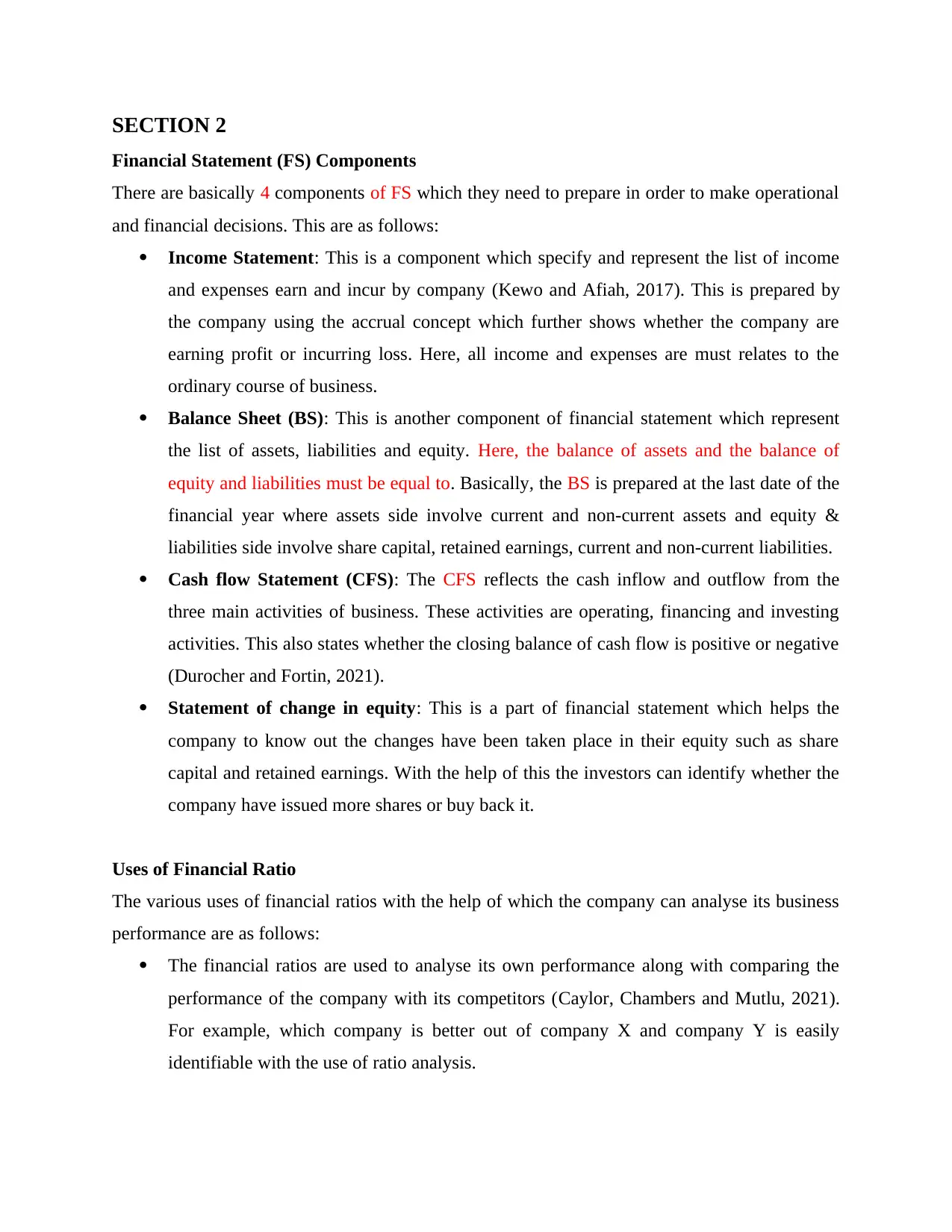
SECTION 2
Financial Statement (FS) Components
There are basically 4 components of FS which they need to prepare in order to make operational
and financial decisions. This are as follows:
Income Statement: This is a component which specify and represent the list of income
and expenses earn and incur by company (Kewo and Afiah, 2017). This is prepared by
the company using the accrual concept which further shows whether the company are
earning profit or incurring loss. Here, all income and expenses are must relates to the
ordinary course of business.
Balance Sheet (BS): This is another component of financial statement which represent
the list of assets, liabilities and equity. Here, the balance of assets and the balance of
equity and liabilities must be equal to. Basically, the BS is prepared at the last date of the
financial year where assets side involve current and non-current assets and equity &
liabilities side involve share capital, retained earnings, current and non-current liabilities.
Cash flow Statement (CFS): The CFS reflects the cash inflow and outflow from the
three main activities of business. These activities are operating, financing and investing
activities. This also states whether the closing balance of cash flow is positive or negative
(Durocher and Fortin, 2021).
Statement of change in equity: This is a part of financial statement which helps the
company to know out the changes have been taken place in their equity such as share
capital and retained earnings. With the help of this the investors can identify whether the
company have issued more shares or buy back it.
Uses of Financial Ratio
The various uses of financial ratios with the help of which the company can analyse its business
performance are as follows:
The financial ratios are used to analyse its own performance along with comparing the
performance of the company with its competitors (Caylor, Chambers and Mutlu, 2021).
For example, which company is better out of company X and company Y is easily
identifiable with the use of ratio analysis.
Financial Statement (FS) Components
There are basically 4 components of FS which they need to prepare in order to make operational
and financial decisions. This are as follows:
Income Statement: This is a component which specify and represent the list of income
and expenses earn and incur by company (Kewo and Afiah, 2017). This is prepared by
the company using the accrual concept which further shows whether the company are
earning profit or incurring loss. Here, all income and expenses are must relates to the
ordinary course of business.
Balance Sheet (BS): This is another component of financial statement which represent
the list of assets, liabilities and equity. Here, the balance of assets and the balance of
equity and liabilities must be equal to. Basically, the BS is prepared at the last date of the
financial year where assets side involve current and non-current assets and equity &
liabilities side involve share capital, retained earnings, current and non-current liabilities.
Cash flow Statement (CFS): The CFS reflects the cash inflow and outflow from the
three main activities of business. These activities are operating, financing and investing
activities. This also states whether the closing balance of cash flow is positive or negative
(Durocher and Fortin, 2021).
Statement of change in equity: This is a part of financial statement which helps the
company to know out the changes have been taken place in their equity such as share
capital and retained earnings. With the help of this the investors can identify whether the
company have issued more shares or buy back it.
Uses of Financial Ratio
The various uses of financial ratios with the help of which the company can analyse its business
performance are as follows:
The financial ratios are used to analyse its own performance along with comparing the
performance of the company with its competitors (Caylor, Chambers and Mutlu, 2021).
For example, which company is better out of company X and company Y is easily
identifiable with the use of ratio analysis.
Paraphrase This Document
Need a fresh take? Get an instant paraphrase of this document with our AI Paraphraser
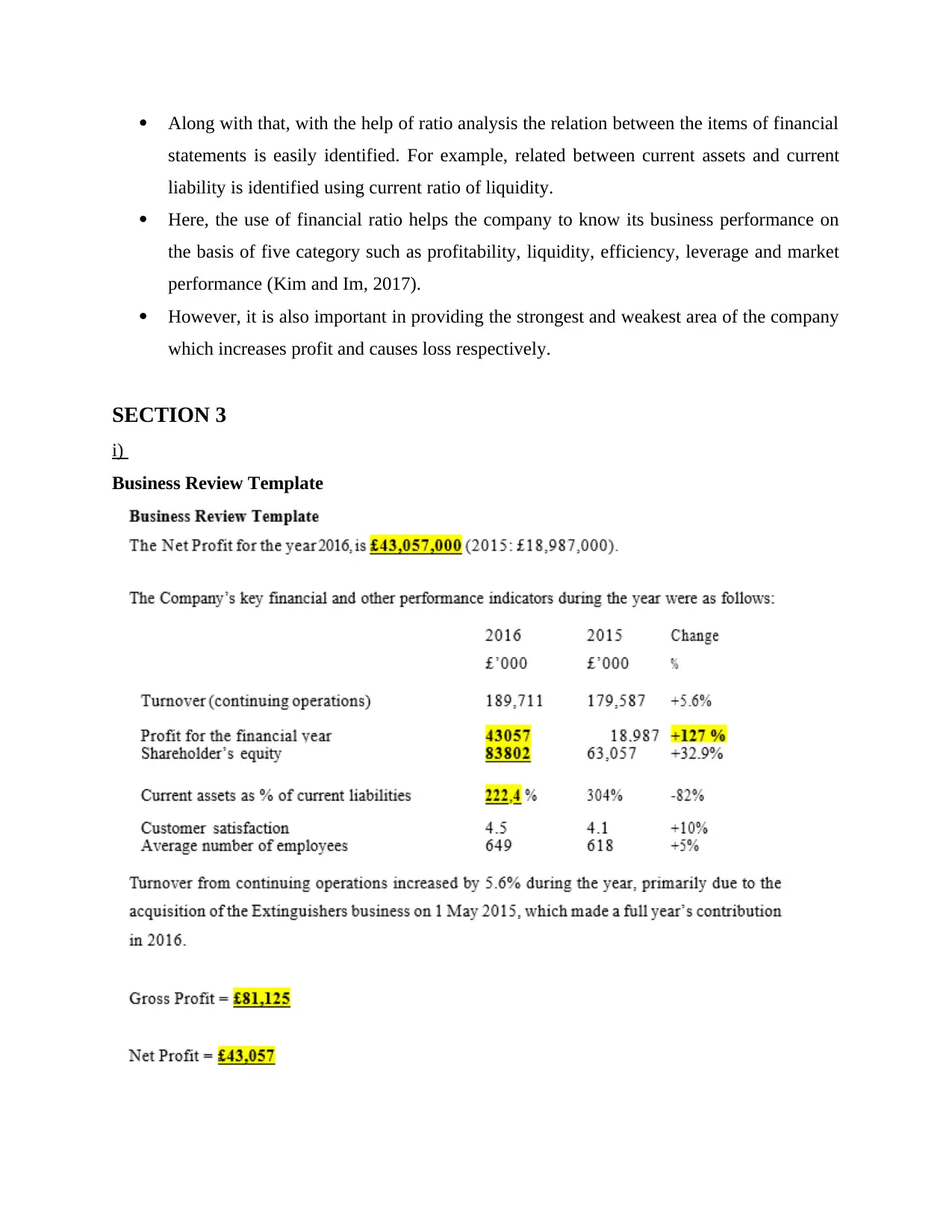
Along with that, with the help of ratio analysis the relation between the items of financial
statements is easily identified. For example, related between current assets and current
liability is identified using current ratio of liquidity.
Here, the use of financial ratio helps the company to know its business performance on
the basis of five category such as profitability, liquidity, efficiency, leverage and market
performance (Kim and Im, 2017).
However, it is also important in providing the strongest and weakest area of the company
which increases profit and causes loss respectively.
SECTION 3
i)
Business Review Template
statements is easily identified. For example, related between current assets and current
liability is identified using current ratio of liquidity.
Here, the use of financial ratio helps the company to know its business performance on
the basis of five category such as profitability, liquidity, efficiency, leverage and market
performance (Kim and Im, 2017).
However, it is also important in providing the strongest and weakest area of the company
which increases profit and causes loss respectively.
SECTION 3
i)
Business Review Template
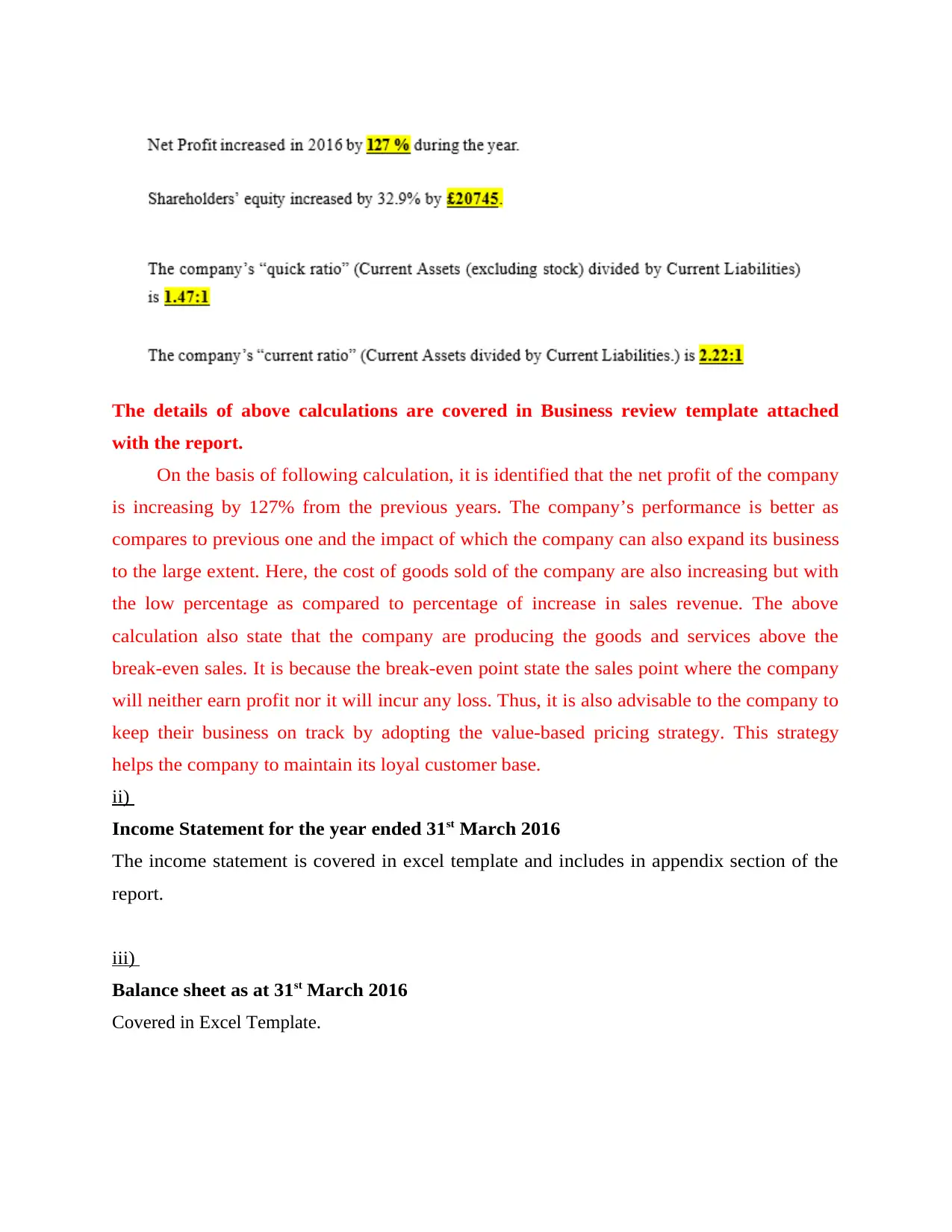
The details of above calculations are covered in Business review template attached
with the report.
On the basis of following calculation, it is identified that the net profit of the company
is increasing by 127% from the previous years. The company’s performance is better as
compares to previous one and the impact of which the company can also expand its business
to the large extent. Here, the cost of goods sold of the company are also increasing but with
the low percentage as compared to percentage of increase in sales revenue. The above
calculation also state that the company are producing the goods and services above the
break-even sales. It is because the break-even point state the sales point where the company
will neither earn profit nor it will incur any loss. Thus, it is also advisable to the company to
keep their business on track by adopting the value-based pricing strategy. This strategy
helps the company to maintain its loyal customer base.
ii)
Income Statement for the year ended 31 st March 2016
The income statement is covered in excel template and includes in appendix section of the
report.
iii)
Balance sheet as at 31 st March 2016
Covered in Excel Template.
with the report.
On the basis of following calculation, it is identified that the net profit of the company
is increasing by 127% from the previous years. The company’s performance is better as
compares to previous one and the impact of which the company can also expand its business
to the large extent. Here, the cost of goods sold of the company are also increasing but with
the low percentage as compared to percentage of increase in sales revenue. The above
calculation also state that the company are producing the goods and services above the
break-even sales. It is because the break-even point state the sales point where the company
will neither earn profit nor it will incur any loss. Thus, it is also advisable to the company to
keep their business on track by adopting the value-based pricing strategy. This strategy
helps the company to maintain its loyal customer base.
ii)
Income Statement for the year ended 31 st March 2016
The income statement is covered in excel template and includes in appendix section of the
report.
iii)
Balance sheet as at 31 st March 2016
Covered in Excel Template.
⊘ This is a preview!⊘
Do you want full access?
Subscribe today to unlock all pages.

Trusted by 1+ million students worldwide
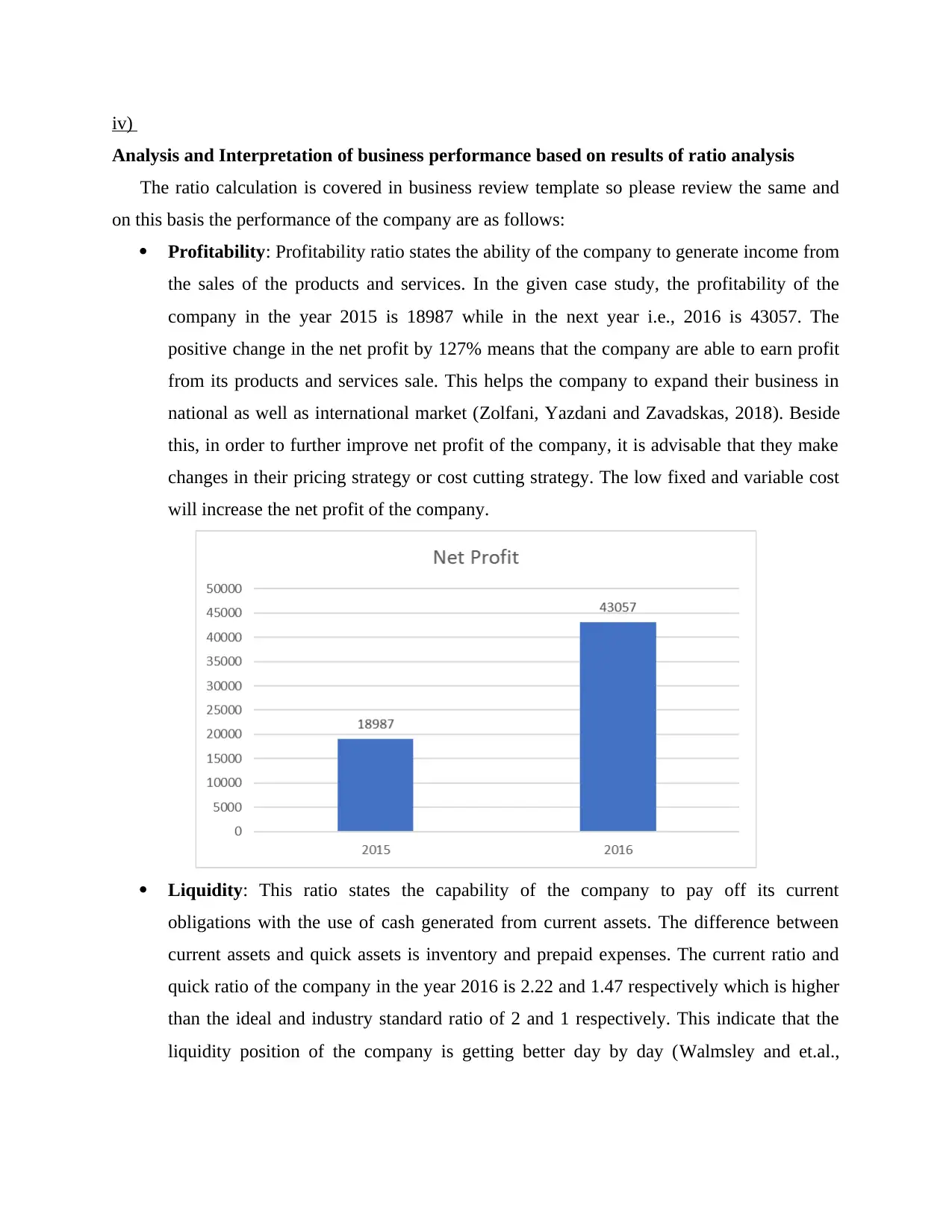
iv)
Analysis and Interpretation of business performance based on results of ratio analysis
The ratio calculation is covered in business review template so please review the same and
on this basis the performance of the company are as follows:
Profitability: Profitability ratio states the ability of the company to generate income from
the sales of the products and services. In the given case study, the profitability of the
company in the year 2015 is 18987 while in the next year i.e., 2016 is 43057. The
positive change in the net profit by 127% means that the company are able to earn profit
from its products and services sale. This helps the company to expand their business in
national as well as international market (Zolfani, Yazdani and Zavadskas, 2018). Beside
this, in order to further improve net profit of the company, it is advisable that they make
changes in their pricing strategy or cost cutting strategy. The low fixed and variable cost
will increase the net profit of the company.
Liquidity: This ratio states the capability of the company to pay off its current
obligations with the use of cash generated from current assets. The difference between
current assets and quick assets is inventory and prepaid expenses. The current ratio and
quick ratio of the company in the year 2016 is 2.22 and 1.47 respectively which is higher
than the ideal and industry standard ratio of 2 and 1 respectively. This indicate that the
liquidity position of the company is getting better day by day (Walmsley and et.al.,
Analysis and Interpretation of business performance based on results of ratio analysis
The ratio calculation is covered in business review template so please review the same and
on this basis the performance of the company are as follows:
Profitability: Profitability ratio states the ability of the company to generate income from
the sales of the products and services. In the given case study, the profitability of the
company in the year 2015 is 18987 while in the next year i.e., 2016 is 43057. The
positive change in the net profit by 127% means that the company are able to earn profit
from its products and services sale. This helps the company to expand their business in
national as well as international market (Zolfani, Yazdani and Zavadskas, 2018). Beside
this, in order to further improve net profit of the company, it is advisable that they make
changes in their pricing strategy or cost cutting strategy. The low fixed and variable cost
will increase the net profit of the company.
Liquidity: This ratio states the capability of the company to pay off its current
obligations with the use of cash generated from current assets. The difference between
current assets and quick assets is inventory and prepaid expenses. The current ratio and
quick ratio of the company in the year 2016 is 2.22 and 1.47 respectively which is higher
than the ideal and industry standard ratio of 2 and 1 respectively. This indicate that the
liquidity position of the company is getting better day by day (Walmsley and et.al.,
Paraphrase This Document
Need a fresh take? Get an instant paraphrase of this document with our AI Paraphraser
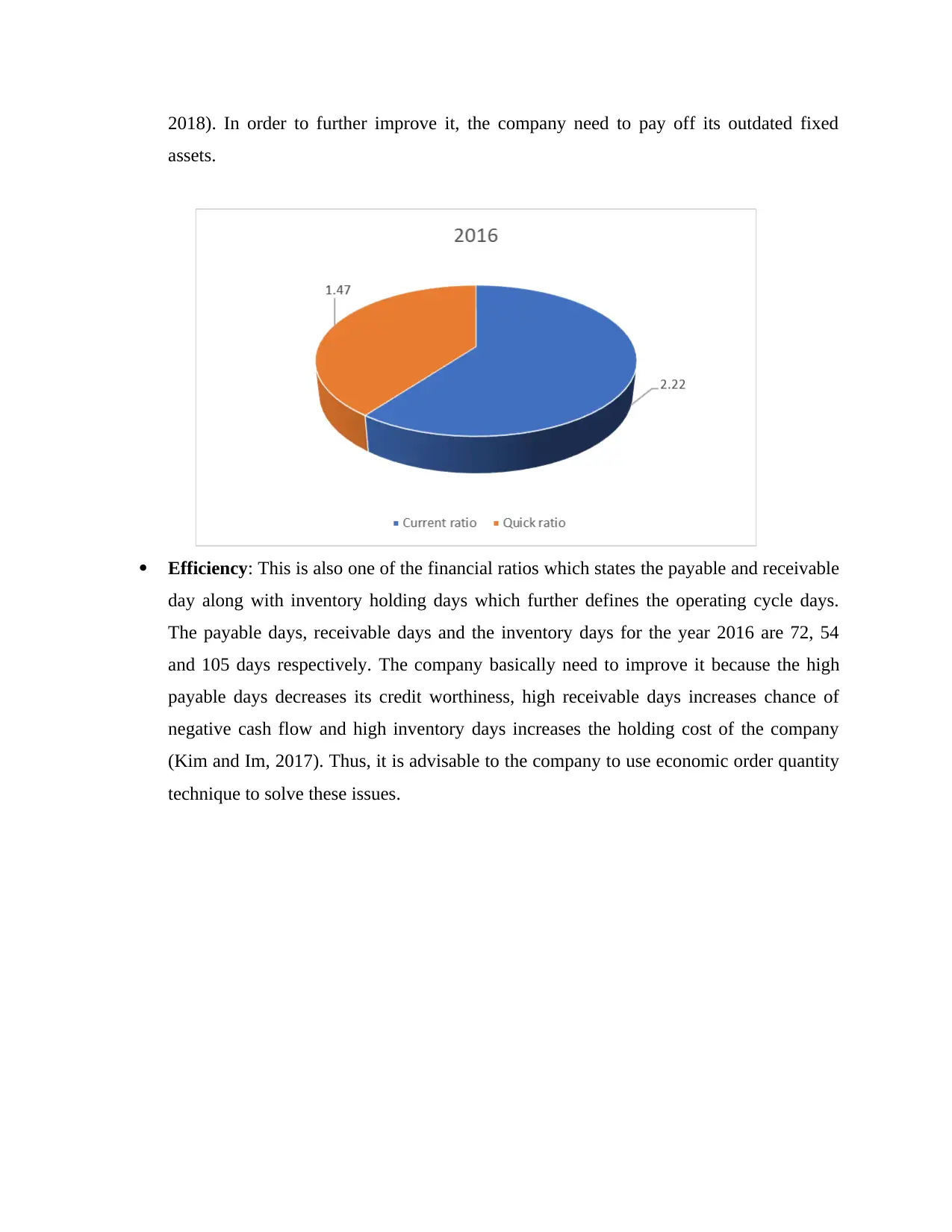
2018). In order to further improve it, the company need to pay off its outdated fixed
assets.
Efficiency: This is also one of the financial ratios which states the payable and receivable
day along with inventory holding days which further defines the operating cycle days.
The payable days, receivable days and the inventory days for the year 2016 are 72, 54
and 105 days respectively. The company basically need to improve it because the high
payable days decreases its credit worthiness, high receivable days increases chance of
negative cash flow and high inventory days increases the holding cost of the company
(Kim and Im, 2017). Thus, it is advisable to the company to use economic order quantity
technique to solve these issues.
assets.
Efficiency: This is also one of the financial ratios which states the payable and receivable
day along with inventory holding days which further defines the operating cycle days.
The payable days, receivable days and the inventory days for the year 2016 are 72, 54
and 105 days respectively. The company basically need to improve it because the high
payable days decreases its credit worthiness, high receivable days increases chance of
negative cash flow and high inventory days increases the holding cost of the company
(Kim and Im, 2017). Thus, it is advisable to the company to use economic order quantity
technique to solve these issues.
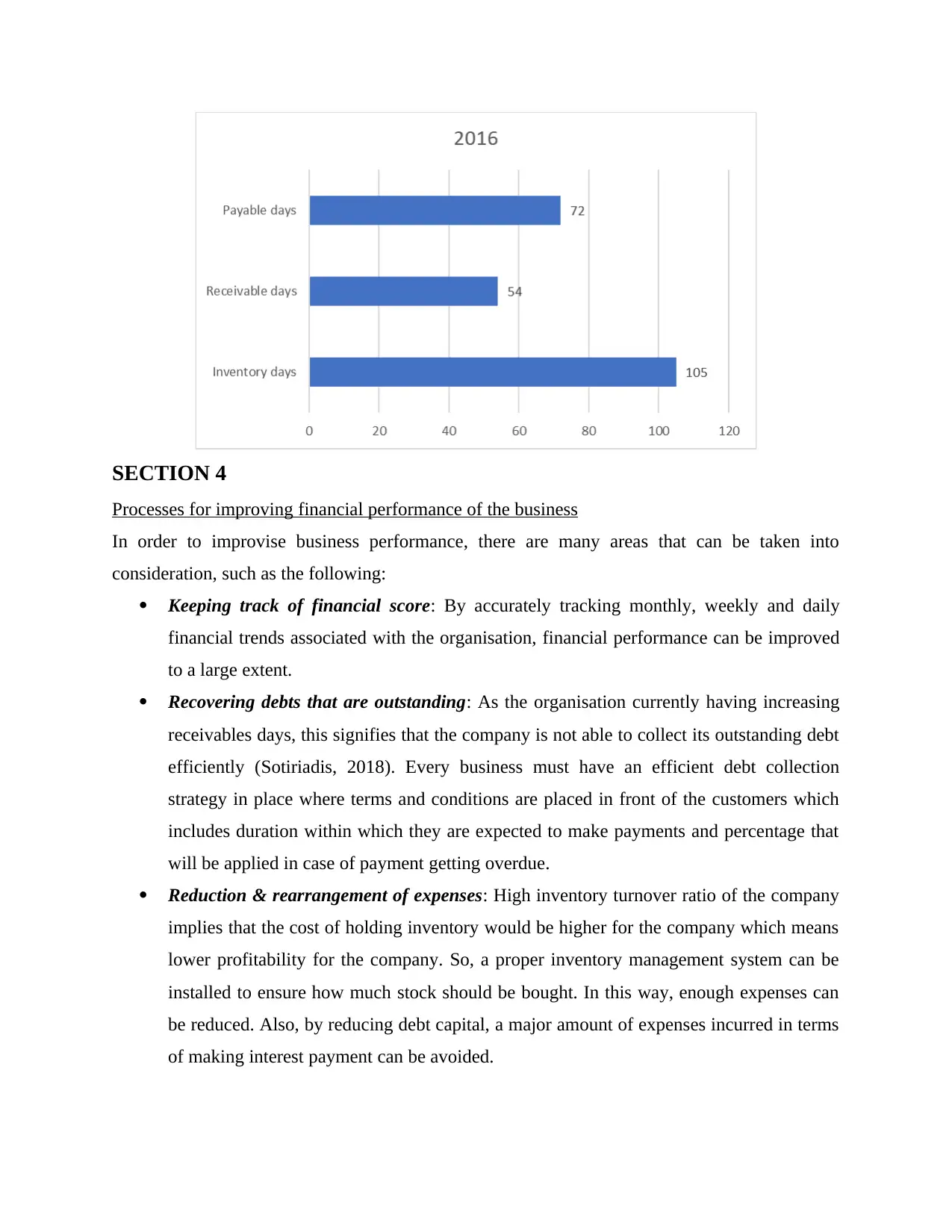
SECTION 4
Processes for improving financial performance of the business
In order to improvise business performance, there are many areas that can be taken into
consideration, such as the following:
Keeping track of financial score: By accurately tracking monthly, weekly and daily
financial trends associated with the organisation, financial performance can be improved
to a large extent.
Recovering debts that are outstanding: As the organisation currently having increasing
receivables days, this signifies that the company is not able to collect its outstanding debt
efficiently (Sotiriadis, 2018). Every business must have an efficient debt collection
strategy in place where terms and conditions are placed in front of the customers which
includes duration within which they are expected to make payments and percentage that
will be applied in case of payment getting overdue.
Reduction & rearrangement of expenses: High inventory turnover ratio of the company
implies that the cost of holding inventory would be higher for the company which means
lower profitability for the company. So, a proper inventory management system can be
installed to ensure how much stock should be bought. In this way, enough expenses can
be reduced. Also, by reducing debt capital, a major amount of expenses incurred in terms
of making interest payment can be avoided.
Processes for improving financial performance of the business
In order to improvise business performance, there are many areas that can be taken into
consideration, such as the following:
Keeping track of financial score: By accurately tracking monthly, weekly and daily
financial trends associated with the organisation, financial performance can be improved
to a large extent.
Recovering debts that are outstanding: As the organisation currently having increasing
receivables days, this signifies that the company is not able to collect its outstanding debt
efficiently (Sotiriadis, 2018). Every business must have an efficient debt collection
strategy in place where terms and conditions are placed in front of the customers which
includes duration within which they are expected to make payments and percentage that
will be applied in case of payment getting overdue.
Reduction & rearrangement of expenses: High inventory turnover ratio of the company
implies that the cost of holding inventory would be higher for the company which means
lower profitability for the company. So, a proper inventory management system can be
installed to ensure how much stock should be bought. In this way, enough expenses can
be reduced. Also, by reducing debt capital, a major amount of expenses incurred in terms
of making interest payment can be avoided.
⊘ This is a preview!⊘
Do you want full access?
Subscribe today to unlock all pages.

Trusted by 1+ million students worldwide
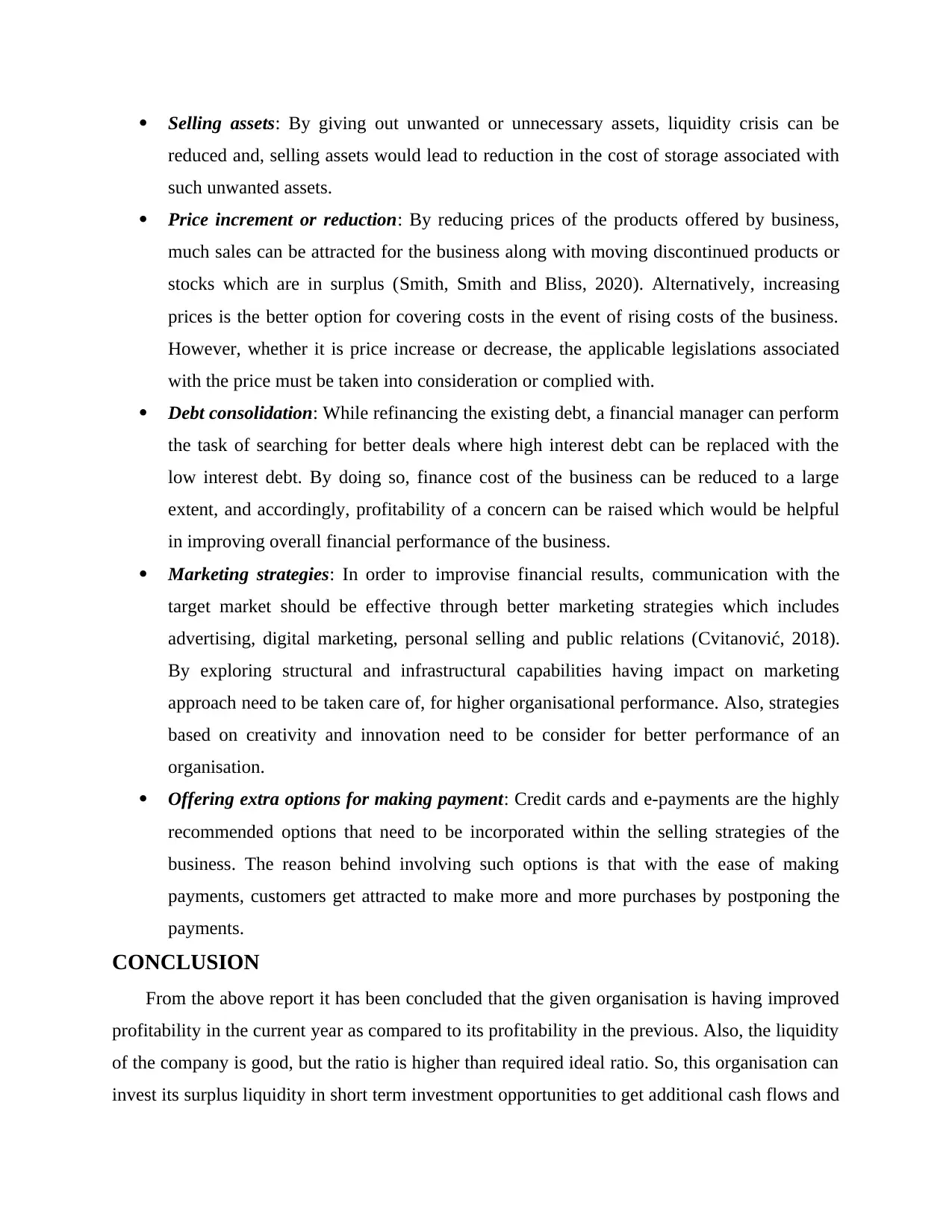
Selling assets: By giving out unwanted or unnecessary assets, liquidity crisis can be
reduced and, selling assets would lead to reduction in the cost of storage associated with
such unwanted assets.
Price increment or reduction: By reducing prices of the products offered by business,
much sales can be attracted for the business along with moving discontinued products or
stocks which are in surplus (Smith, Smith and Bliss, 2020). Alternatively, increasing
prices is the better option for covering costs in the event of rising costs of the business.
However, whether it is price increase or decrease, the applicable legislations associated
with the price must be taken into consideration or complied with.
Debt consolidation: While refinancing the existing debt, a financial manager can perform
the task of searching for better deals where high interest debt can be replaced with the
low interest debt. By doing so, finance cost of the business can be reduced to a large
extent, and accordingly, profitability of a concern can be raised which would be helpful
in improving overall financial performance of the business.
Marketing strategies: In order to improvise financial results, communication with the
target market should be effective through better marketing strategies which includes
advertising, digital marketing, personal selling and public relations (Cvitanović, 2018).
By exploring structural and infrastructural capabilities having impact on marketing
approach need to be taken care of, for higher organisational performance. Also, strategies
based on creativity and innovation need to be consider for better performance of an
organisation.
Offering extra options for making payment: Credit cards and e-payments are the highly
recommended options that need to be incorporated within the selling strategies of the
business. The reason behind involving such options is that with the ease of making
payments, customers get attracted to make more and more purchases by postponing the
payments.
CONCLUSION
From the above report it has been concluded that the given organisation is having improved
profitability in the current year as compared to its profitability in the previous. Also, the liquidity
of the company is good, but the ratio is higher than required ideal ratio. So, this organisation can
invest its surplus liquidity in short term investment opportunities to get additional cash flows and
reduced and, selling assets would lead to reduction in the cost of storage associated with
such unwanted assets.
Price increment or reduction: By reducing prices of the products offered by business,
much sales can be attracted for the business along with moving discontinued products or
stocks which are in surplus (Smith, Smith and Bliss, 2020). Alternatively, increasing
prices is the better option for covering costs in the event of rising costs of the business.
However, whether it is price increase or decrease, the applicable legislations associated
with the price must be taken into consideration or complied with.
Debt consolidation: While refinancing the existing debt, a financial manager can perform
the task of searching for better deals where high interest debt can be replaced with the
low interest debt. By doing so, finance cost of the business can be reduced to a large
extent, and accordingly, profitability of a concern can be raised which would be helpful
in improving overall financial performance of the business.
Marketing strategies: In order to improvise financial results, communication with the
target market should be effective through better marketing strategies which includes
advertising, digital marketing, personal selling and public relations (Cvitanović, 2018).
By exploring structural and infrastructural capabilities having impact on marketing
approach need to be taken care of, for higher organisational performance. Also, strategies
based on creativity and innovation need to be consider for better performance of an
organisation.
Offering extra options for making payment: Credit cards and e-payments are the highly
recommended options that need to be incorporated within the selling strategies of the
business. The reason behind involving such options is that with the ease of making
payments, customers get attracted to make more and more purchases by postponing the
payments.
CONCLUSION
From the above report it has been concluded that the given organisation is having improved
profitability in the current year as compared to its profitability in the previous. Also, the liquidity
of the company is good, but the ratio is higher than required ideal ratio. So, this organisation can
invest its surplus liquidity in short term investment opportunities to get additional cash flows and
Paraphrase This Document
Need a fresh take? Get an instant paraphrase of this document with our AI Paraphraser
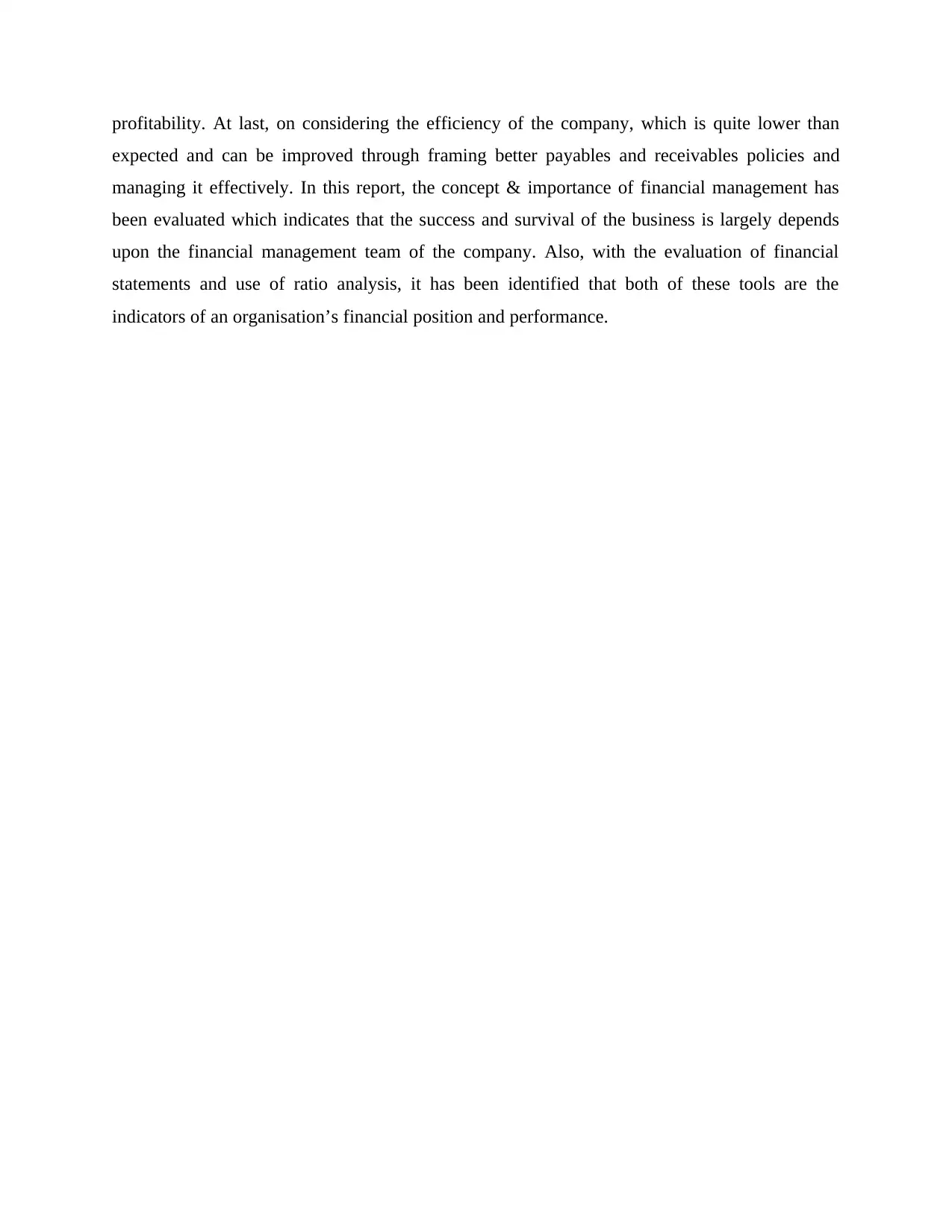
profitability. At last, on considering the efficiency of the company, which is quite lower than
expected and can be improved through framing better payables and receivables policies and
managing it effectively. In this report, the concept & importance of financial management has
been evaluated which indicates that the success and survival of the business is largely depends
upon the financial management team of the company. Also, with the evaluation of financial
statements and use of ratio analysis, it has been identified that both of these tools are the
indicators of an organisation’s financial position and performance.
expected and can be improved through framing better payables and receivables policies and
managing it effectively. In this report, the concept & importance of financial management has
been evaluated which indicates that the success and survival of the business is largely depends
upon the financial management team of the company. Also, with the evaluation of financial
statements and use of ratio analysis, it has been identified that both of these tools are the
indicators of an organisation’s financial position and performance.
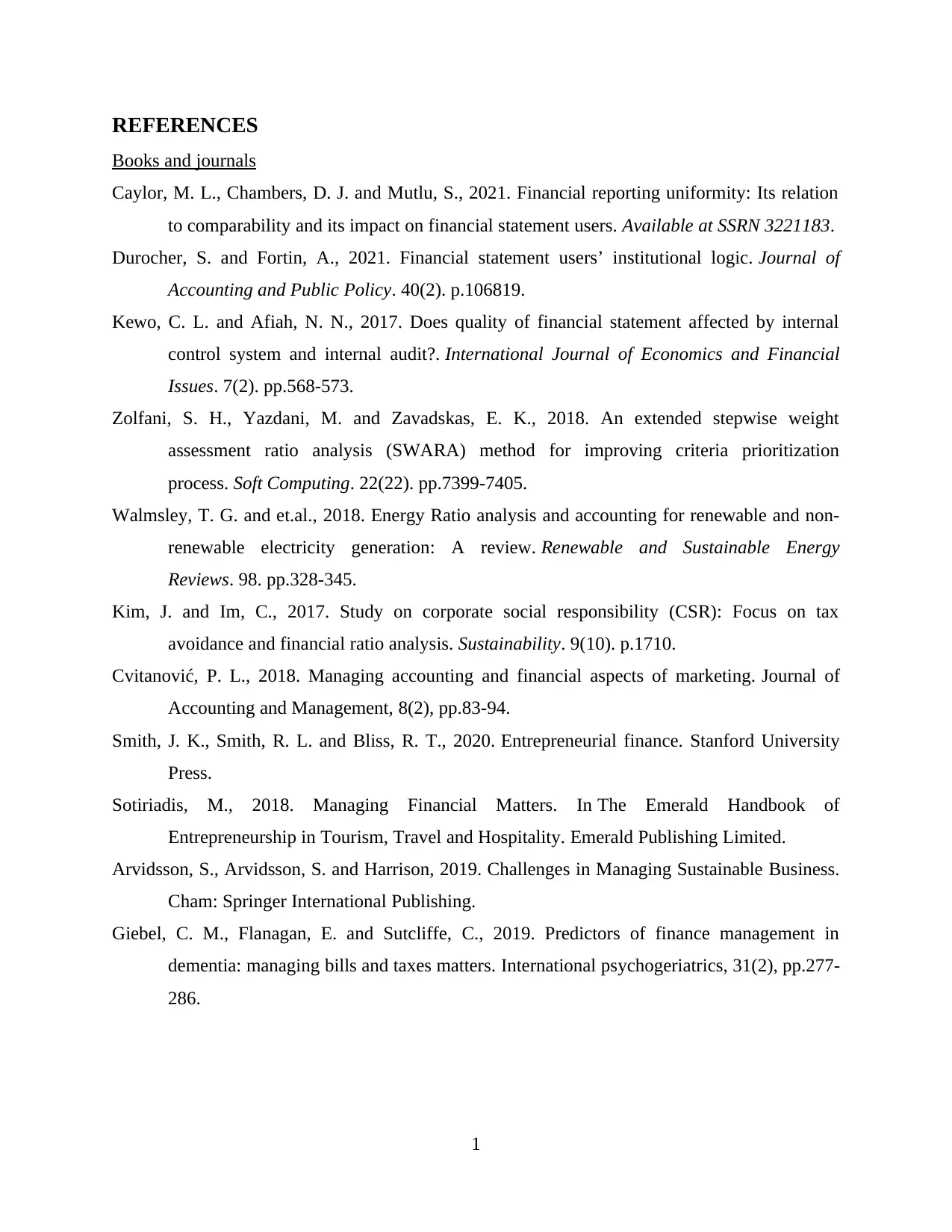
REFERENCES
Books and journals
Caylor, M. L., Chambers, D. J. and Mutlu, S., 2021. Financial reporting uniformity: Its relation
to comparability and its impact on financial statement users. Available at SSRN 3221183.
Durocher, S. and Fortin, A., 2021. Financial statement users’ institutional logic. Journal of
Accounting and Public Policy. 40(2). p.106819.
Kewo, C. L. and Afiah, N. N., 2017. Does quality of financial statement affected by internal
control system and internal audit?. International Journal of Economics and Financial
Issues. 7(2). pp.568-573.
Zolfani, S. H., Yazdani, M. and Zavadskas, E. K., 2018. An extended stepwise weight
assessment ratio analysis (SWARA) method for improving criteria prioritization
process. Soft Computing. 22(22). pp.7399-7405.
Walmsley, T. G. and et.al., 2018. Energy Ratio analysis and accounting for renewable and non-
renewable electricity generation: A review. Renewable and Sustainable Energy
Reviews. 98. pp.328-345.
Kim, J. and Im, C., 2017. Study on corporate social responsibility (CSR): Focus on tax
avoidance and financial ratio analysis. Sustainability. 9(10). p.1710.
Cvitanović, P. L., 2018. Managing accounting and financial aspects of marketing. Journal of
Accounting and Management, 8(2), pp.83-94.
Smith, J. K., Smith, R. L. and Bliss, R. T., 2020. Entrepreneurial finance. Stanford University
Press.
Sotiriadis, M., 2018. Managing Financial Matters. In The Emerald Handbook of
Entrepreneurship in Tourism, Travel and Hospitality. Emerald Publishing Limited.
Arvidsson, S., Arvidsson, S. and Harrison, 2019. Challenges in Managing Sustainable Business.
Cham: Springer International Publishing.
Giebel, C. M., Flanagan, E. and Sutcliffe, C., 2019. Predictors of finance management in
dementia: managing bills and taxes matters. International psychogeriatrics, 31(2), pp.277-
286.
1
Books and journals
Caylor, M. L., Chambers, D. J. and Mutlu, S., 2021. Financial reporting uniformity: Its relation
to comparability and its impact on financial statement users. Available at SSRN 3221183.
Durocher, S. and Fortin, A., 2021. Financial statement users’ institutional logic. Journal of
Accounting and Public Policy. 40(2). p.106819.
Kewo, C. L. and Afiah, N. N., 2017. Does quality of financial statement affected by internal
control system and internal audit?. International Journal of Economics and Financial
Issues. 7(2). pp.568-573.
Zolfani, S. H., Yazdani, M. and Zavadskas, E. K., 2018. An extended stepwise weight
assessment ratio analysis (SWARA) method for improving criteria prioritization
process. Soft Computing. 22(22). pp.7399-7405.
Walmsley, T. G. and et.al., 2018. Energy Ratio analysis and accounting for renewable and non-
renewable electricity generation: A review. Renewable and Sustainable Energy
Reviews. 98. pp.328-345.
Kim, J. and Im, C., 2017. Study on corporate social responsibility (CSR): Focus on tax
avoidance and financial ratio analysis. Sustainability. 9(10). p.1710.
Cvitanović, P. L., 2018. Managing accounting and financial aspects of marketing. Journal of
Accounting and Management, 8(2), pp.83-94.
Smith, J. K., Smith, R. L. and Bliss, R. T., 2020. Entrepreneurial finance. Stanford University
Press.
Sotiriadis, M., 2018. Managing Financial Matters. In The Emerald Handbook of
Entrepreneurship in Tourism, Travel and Hospitality. Emerald Publishing Limited.
Arvidsson, S., Arvidsson, S. and Harrison, 2019. Challenges in Managing Sustainable Business.
Cham: Springer International Publishing.
Giebel, C. M., Flanagan, E. and Sutcliffe, C., 2019. Predictors of finance management in
dementia: managing bills and taxes matters. International psychogeriatrics, 31(2), pp.277-
286.
1
⊘ This is a preview!⊘
Do you want full access?
Subscribe today to unlock all pages.

Trusted by 1+ million students worldwide
1 out of 14
Related Documents
Your All-in-One AI-Powered Toolkit for Academic Success.
+13062052269
info@desklib.com
Available 24*7 on WhatsApp / Email
![[object Object]](/_next/static/media/star-bottom.7253800d.svg)
Unlock your academic potential
Copyright © 2020–2025 A2Z Services. All Rights Reserved. Developed and managed by ZUCOL.





